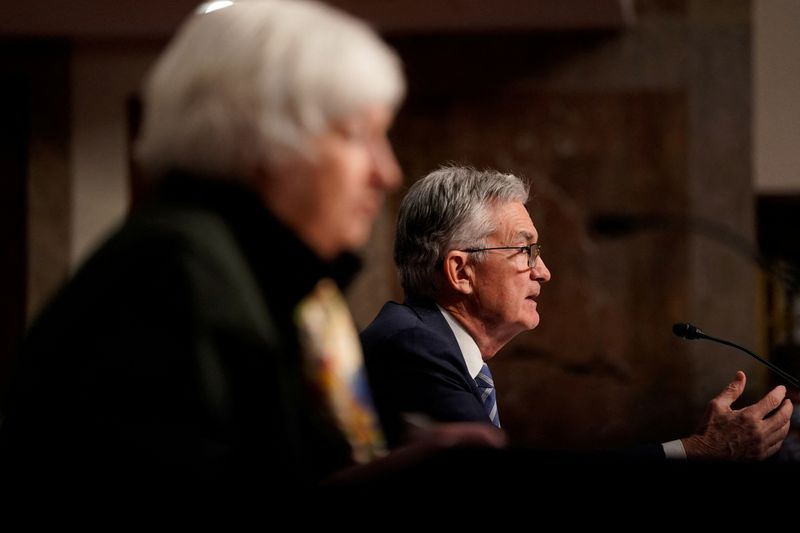(Corrects name of Bloomberg Global Aggregate index in the last paragraph to remove Barclays (LON:BARC))
By Karen Brettell and Gertrude Chavez-Dreyfuss
(Reuters) - U.S. Treasuries are facing a perfect storm that could send benchmark yields to their highest level in almost two years, as investors fret over a more hawkish Federal Reserve, surging inflation and a deluge of supply.
Benchmark 10-year yields on Thursday jumped to 1.753%, up from a low of 1.491% at year-end and 1.353% on Dec. 20. The yields are now holding just below the 1.776% level reached in March 2021, which was the highest yield since February 2020.
Analysts say a definitive break above technical resistance up to around 1.79% would likely signal further gains to the 2% area.
The latter half of 2021 saw several rallies in the benchmark yield, which moves inversely to bond prices, fail around current levels as markets were hit by worries over COVID-19, economic growth and as investors sought out U.S. debt for its relatively higher yields.
Investors increasingly believe this time may be different, not least because a hawkish Fed appears ready to pull out the stops in its fight against surging inflation.
Yields took an extra leg higher after minutes from the Fed's December meeting released on Wednesday showed that officials had discussed shrinking the U.S. central bank’s overall asset holdings as well as raising interest rates sooner than expected to fight inflation.
“This talk about letting the balance sheet runoff and envisaging a future where there are no more Fed purchases… people are going to prepare for that now,” said Tom Simons, a money market economist at Jefferies.
Other factors pressuring yields include corporate debt issuers locking in rates as they rush to beat rate hikes, and a broad market repricing of bonds after safe-haven demand helped to push yields too low relative to fundamentals at year-end.
Demand for bonds relative to supply is also expected to worsen this year as central banks pare back purchases. The Fed only two months ago was buying an extra $120 bln a month in bonds.
HAWKISH FED
The Fed is under pressure hasten the removal of its extraordinary accommodation as surging price pressures prove more stubborn than previously thought. The rapid spread of the Omicron coronavirus variant may also add to supply disruptions, potentially increasing upward pressure on inflation.
A surprisingly strong ADP National Employment Report on Wednesday also suggests that the labor market recovery may justify raising rates. The U.S. government will release its highly-anticipated jobs report for December on Friday.
“It looks like the conditions for Fed rate hikes have pretty much been met with the labor market now pretty robust,” said Kim Rupert, managing director in global fixed income analysis at Action Economics, though she noted that holiday-season could have created data anomalies.
Fed funds futures are now fully pricing in three rate hikes by the end of 2022, with the first increase likely as soon as March.
SUPPLY-DEMAND BALANCE
A rush by corporates to borrow in the bond markets before the Fed hikes rates is adding to Treasury weakness as issuers enter into agreements to lock in rates for the sales.
"It looks like companies are trying to raise debt as soon as possible. As rates rise, there's going to be more and more discussions of issuing debt now rather than wait to do it at a better level," said Tom di Galoma, a managing director at Seaport Global Holdings in New York.
The global bond supply-demand balance is also set to worsen this year as central banks, including the Fed and the European Central Bank (ECB), continue to reduce bond purchases, which could put more upward pressure on yields.
JPMorgan (NYSE:JPM) analysts including Nikolaos Panigirtzoglou said in a report on Wednesday that if the Fed begins winding down its balance sheet after just two hikes in September, the market might need to absorb an additional $150 billion of net Treasury issuance in the last quarter of 2022.
If Congress passes new spending in the form of the Build Back Better Act, net issuance could further climb by around $200 billion this year, which accounts for $250 billion in new spending, and $50 billion in taxes.
JPMorgan is forecasting a deterioration of $1.1 trillion in global bond supply and demand this year relative to 2021, which could push yields in the Bloomberg Global Aggregate index upwards by 30 basis points.
(This story corrects name of Bloomberg Global Aggregate index in the last paragraph to remove Barclays)
